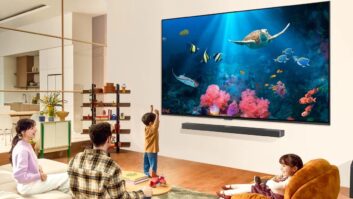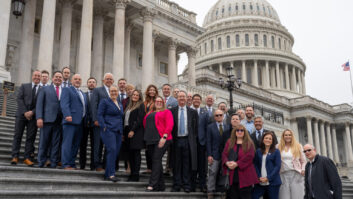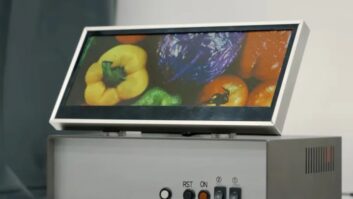It’s easy amid the hoopla each year at International CES in Las Vegas to forget that the Consumer Electronics Association (CEA), the producer of the annual electronic lollapalooza, works throughout the year in the nation’s capital and elsewhere to promote and protect the interests of consumers, its member companies and the industry.
And this past year has been especially busy with issues of international trade, the digital television transition and the environmental impact of the proliferation of digital products dominating the conversation.
“There will certainly be a major focus on trade in 2008,” noted Michael Petricone, CEA’s government affairs senior VP. “Consumer electronics is the quintessential multinational industry, and the ability of the U.S. to maintain its innovation and economic leadership position depends in large part on an open marketplace.” That ability is threatened, Petricone suggested, by a consensus, in the media and in some segments of government, moving away from free trade.
“We’re going to make it clear to policy makers that trade creates jobs and allows small businesses to compete and invigorate our industry,” Petricone added. “Trade is one issue that unites every one of our members, whether it’s because they are sourcing product overseas, exporting goods or recruiting talent worldwide.” To that effect, CEA last fall launched a multifaceted campaign including advertising in Capital Hill publications, urging Congress to reject protectionism and pass trade agreements that will expand the economy and create new American jobs.
Petricone pointed out that last year there were a number of bills in various committees in Congress for tariffs on imports from China or other restrictions that would create difficulties for consumer electronics companies. There will likely be more this year in an atmosphere so heated that CEA president/CEO Gary Shapiro openly challenged arch-protectionist TV commentator Lou Dobbs to a debate on the subject. (As of this writing, Dobbs had not taken up the gauntlet.)
For more than a century, the United States has been the world economic and innovation leader, a magnet for people to come and develop technologies, products and companies. The stakes are indeed high when trade and immigration are the issues, threatening electronics industry’s long tradition for the first- and second-generation immigrants founding and building companies like Intel, Google and Yahoo! among others. Trade issues will undoubtedly be a major topic at the annual CEA Washington Forum, which takes place this year April 2-4.
The digital television transition will also be front and center this year since 2008 is the last full year of analog television broadcasts. There has actually been a good deal of cooperation among the various stakeholder industries in the transition, including TV makers, broadcasters, cable and satellite companies to get the word out to consumers that the analog cutoff is coming (on Feb. 17, 2009) and that there’s really no reason to panic. Cable and satellite customers won’t be affected at all and over-the-air television viewers have a number of options including purchasing an inexpensive converter box to show digital TV on an existing analog set. The cost of two converter boxes will be underwritten by the federal government which will make two $40 coupons available toward the purchase.
A relatively small number of households rely on over-the-air broadcasts for primary TV reception (10 percent to 15 percent), and there will be inexpensive converter boxes available this year for those who don’t choose to purchase a new digital television at this time. Those digital to analog converter boxes should be in store in the first quarter of this year with a price tag of some $50 to $60. “Our message to consumers,” Petricone said, “is there is no reason to panic since there are lots of good options for consumers.”
Some of that analog spectrum is to be allocated for first responders — police and fire departments, homeland security and others — while the rest will be auctioned for new wireless services. There is sure to be some confusion and worry as the cutoff date approaches and CEA is working with other organizations to facilitate the transition. “We’re really happy with the cooperation among the various stakeholder industries in this transition,” Petricone observed. The cable industry, broadcasters and set makers have undertaken a variety of educational programs to assure all Americans are aware of the transition. “We’re combating fear with facts,” Petricone said, “and we expect everything to work out smoothly.”
Of course, environmental issues will also be prominent this year. (Those who are reading this at CES in Las Vegas are participating in the first “Green CES,” with recycling and energy efficiency factored into all elements of a “carbon neutral” show. Individual companies and the consumer electronics industry as a whole have made great strides in recent years making products more energy efficient and disposing or old products responsibly, recycling materials wherever possible. CEA’s efforts in Washington continue to focus on the goal of national e-waste and energy efficiency standards rather than a state-by-state patchwork quilt of regulations. CEA’s new Web site, www.mygreenelectronics.org, is designed to serve consumers and the industry and is emerging as a leading site for information about all things “green.”
There are other issues facing the industry of course — broadband availability, use of electronics devices in vehicles and on aircraft, sales tax holidays and telecommunications policy reform — that keep CEA’s government affairs personnel busy year round.
And the continued protection of consumers rights to use their lawfully acquired devices and content, and to time shift and place shift that content, remains a top priority that can be explored at www.digitalfreedom.org.
There’s some evidence that the content providers are beginning to “get it,” to understand that even with the difficulties inherent in the transition to digital, the new technologies expand the markets for content. The return of content in a big way to this year’s CES with major exhibits by Sony and Universal among others is another sign of a positive trend that CES is the place to be for content, delivery and devices.













